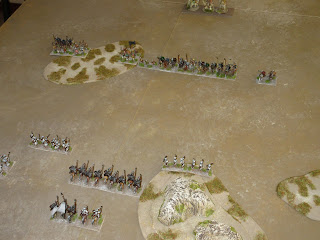In addition to the
modification of existing army lists, the Khawarij, among others, were added.
Their list begins in 658 AD or the later period of the Arab Conquest and ends
in 873 AD during the Abbasid Caliphate. Their differing views on religious and
political matters brought them at odds with the ruling dynasties resulting in
frequent open rebellion over the period of two centuries.
In DBA terms, their fanaticism is noted by the
preponderance of impetuous troop types; their cavalry are classed as knights (3Kn) and the infantry are warband (3Wb) with a unit of mounted scouts, either LCm or LH.
Game 1
Arabic manuals prescribe caution when dealing with the
Khawarij. Following the examples set, the Umayyad were deployed in a deeper
than usual formation with most of the infantry positioned forward of the
cavalry. The Khawarij formed two wings, one of infantry and the second of
cavalry. A small detachment of cavalry protected the right flank.
The Umayyad opened the battle with a retrograde movement
toward their camp. Thinking that the enemy was in flight, individual columns of
infantry pressed forward. Khawarij cavalry held their position smelling
trickery here.
Looking at the Umayyad forming a solid battle line, it
was the cavalry that sprung a surprise attack catching a column of Khawarij
infantry unawares.
In less than 30 minutes (two bounds), the battle turned
to an Umayyad advantage. Umayyad archers positioned on the hill now moved
closer to let loose their arrows. At this moment, the Umayyad infantry moved forward
to finish the scattered units of Khawarij swordsmen and win the battle. Score 4 – 0 for the Umayyad.
Game 2
The Khawarij formed their infantry on the left to
clear the Dailami positioned on the forward slope of the hill. From there, the
Khawarij would sweep down on the Umayyad line leaving their Jund cavalry
unprotected.
Emboldened by their victory in the previous battle,
the Umayyad dispensed with the manuals and attacked. Unfortunately, what
followed was exactly written as a consequence. Despite the superior number of
cavalry, the Khawarij cavalry bested the Umayyad by killing two units of Jund
and the general. Score 4g – 1 for the Khawarij.
Game 3
On the left flank, the Umayyad moved their archers
forward taking advantage of the scrub brush. On the right, the Dailami supported
by skirmishers held the hill leaving the remainder of the army to form up in
front of the camp. The Khawarij kept their two wing formation.
Leapfrogging from scrub to the hill, the archers were
in a good position to rain down arrows on the enemy cavalry. Out of picture, a
unit of Umayyad light horse was quickly approaching the Khawarij camp. Undeterred by this, the Khawarij cavalry remained
nonchalant in position to await their infantry attack.
At this point, the Khawarij infantry had made their
assault only to be repulsed along their entire front. This was the moment the
Khawarij cavalry made their move and charged the Jund cavalry.
Redoubling their effort, the Khawarij renewed their
attack bringing down two Umayyad spear. A third, a unit of Umayyad cavalry fell
in the ensuing melee while at the Khawarij rear, the Umayyad light horse were
ambushed and destroyed by camp guards ending the game. Score 4 – 2 for the Khawarij.
III/31 Umayyad
Arab 661 AD – 750 AD,
1 x General (Cv), 3 x jund cavalry (Cv), 3 x spearmen
(Sp), 3 x archers (3Bw), 1 x Bedouin (LH), 1 x Ghazis or Turkish horse archer
(LH).
III/25c
Khawarij 658 – 873 AD,
1 x General (3Kn), 4 x Khawarij horsemen (3Kn), 5 x
Khawarij swordsmen (3Wb), 1 x archers (3Bw) 1 x Bedouin horse (LH).











Nice looking game, once again splendid armies!
ReplyDeleteBoth are excellent armies.
ReplyDeletePhil and Jeff,
ReplyDeleteThank you both for the kind words.
If you liked these armies, the Abbasid and enemies are even better; the Arab Indian are colourful and the Buyid run a close second.
Those reports should start appearing tomorrow.
Cheers,